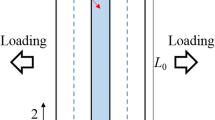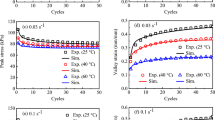Abstract
In the uniaxial deformation mode, the electro-mechanically coupled cyclic deformation of VHB 4905 dielectric elastomer (DE) is systematically studied by the experimental observation and constitutive modeling. From a series of uniaxial electro-mechanically coupled cyclic tests, it is found that with applying a constant voltage, the cyclic softening and ratchetting of VHB 4905 DE are more apparent than that without applying any voltage, which indicate that the VHB 4905 DE exhibits an electro-mechanically coupled effect. Also, the uniaxial electro-mechanically coupled cyclic deformation of VHB 4905 DE presents a strong rate-dependence and remarkable stress-level-dependence. Based on the experimental results, an electro-mechanically coupled visco-hyperelastic constitutive model is proposed by considering the remarkable nonlinear viscosity of VHB 4905 DE and the effect of applied voltage on the cyclic deformation. Comparing the predicted results with correspondent experimental data, it is concluded that the proposed constitutive model reasonably reproduces the uniaxial electro-mechanically coupled cyclic deformation of VHB 4905 DE, including the cyclic softening and ratchetting.














Similar content being viewed by others
References
B. Huang, M.Y. Li, T. Mei, D. McCoul, S.H. Qin, Z.F. Zhao, and J.W. Zhao, Wearable Stretch Sensors for Motion Measurement of the Wrist Joint Based on Dielectric Elastomers, Sensors, 2017, 17(12), p 2708.
O.A. Araromi, S. Rosset, and H.R. Shea, High-Resolution, Large-Area Fabrication of Compliant Electrodes via Laser Ablation for Robust, Stretchable Dielectric Elastomer Actuators and Sensors, ACS Appl. Mater. Interfaces, 2015, 7(32), p 18046–18053.
C.T. Nguyen, H. Phung, T.D. Nguyen, C. Lee, U. Kim, D. Lee, H. Moon, J. Koo, J.D. Nam, and H.R. Choi, A Small Biomimetic Quadruped Robot Driven by Multistacked Dielectric Elastomer Actuators, Smart Mater. Struct., 2014, 23(6), p 065005.
I.A. Anderson, T.A. Gisby, T.G. McKay, B.M. O’Brien, and E.P. Calius, Multi-Functional Dielectric Elastomer Artificial Muscles for Soft and Smart Machines, J. Appl. Phys., 2012, 112(4), p 041101.
K. Di, K.W. Bao, H.J. Chen, X.J. Xie, J.B. Tan, Y.X. Shao, Y.X. Li, W.J. Xia, Z.S. Xu, and E. Shiju, Dielectric Elastomer Generator for Electromechanical Energy Conversion: A Mini Review, Sustainability, 2021, 13(17), p 9881.
M. Wissler and E. Mazza, Mechanical Behavior of an Acrylic Elastomer Used in Dielectric Elastomer Actuators, Sens. Actuator A Phys., 2007, 134(2), p 494–504.
M. Hossain, D.K. Vu, and P. Steinmann, Experimental Study and Numerical Modelling of VHB 4910 Polymer, Comput. Mater. Sci., 2012, 59, p 65–74.
A. Helal, M. Doumit, and R. Shaheen, Biaxial Experimental and Analytical Characterization of a Dielectric Elastomer, Appl. Phys. A Mater. Sci. Process., 2018, 124(2), p 1–11.
D. Ahmad, S.K. Sahu, and K. Patra, Fracture Toughness, Hysteresis and Stretchability of Dielectric Elastomers Under Equibiaxial and Biaxial Loading, Polym. Test., 2019, 79, p 106038.
D. Ahmad and K. Patra, Experimental and Theoretical Analysis of Laterally Pre-Stretched Pure Shear Deformation of Dielectric Elastomer, Polym. Test., 2019, 75, p 291–297.
Z.S. Liao, M. Hossain, X.H. Yao, M. Mehnert, and P. Steinmann, On Thermo-Viscoelastic Experimental Characterization and Numerical Modelling of VHB Polymer, Int. J. Nonlinear Mech., 2020, 118, p 103263.
J.S. Zhang, X.J. Liu, L. Liu, Z.C. Yang, P.F. Li, and H.L. Chen, Modeling and Experimental Study on Dielectric Elastomers Incorporating Humidity Effect, EPL, 2020, 129(5), p 57002.
M. Hossain, D.K. Vu, and P. Steinmann, A Comprehensive Characterization of the Electro-Mechanically Coupled Properties of VHB 4910 Polymer, Arch. Appl. Mech., 2015, 85(4), p 523–537.
M. Mehnert, M. Hossain, and P. Steinmann, Experimental and Numerical Investigations of the Electro-Viscoelastic Behavior of VHB 4905 (TM), Eur. J. Mech. A Solids, 2019, 77, p 103797.
M. Mehnert, M. Hossain, and P. Steinmann, A Complete Thermo-Electro-Viscoelastic Characterization of Dielectric Elastomers, Part I: Experimental Investigations, J. Mech. Phys. Solids, 2021, 157, p 104603.
R.K. Sahu and K. Patra, Rate-Dependent Mechanical Behavior of VHB 4910 Elastomer, Mech. Adv. Mater. Struct., 2016, 23(2), p 170–179.
S. Thylander, A. Menzel, M. Ristinmaa, S. Hall, and J. Engqvist, Electro-Viscoelastic Response of an Acrylic Elastomer Analysed by Digital Image Correlation, Smart Mater. Struct., 2017, 26(8), p 085021.
Y.F. Chen, G.Z. Kang, J.H. Yuan, and T.F. Li, Experimental Study on Pure-Shear-Like Cyclic Deformation of VHB 4910 Dielectric Elastomer, J. Polym. Res., 2019, 26(8), p 1–15.
W. Huang and G. Kang, Experimental Study on Uniaxial Ratchetting of VHB 4910 Dielectric Elastomer, Polym. Test., 2022, 109, p 107557.
Y.F. Chen, G.Z. Kang, J.H. Yuan, T.F. Li, and S.X. Qu, Experimental Investigation on Electro-Mechanically Coupled Cyclic Deformation of Laterally Constrained Dielectric Elastomer, Polym. Test., 2020, 81, p 106220.
K. Patra and R.K. Sahu, A Visco-Hyperelastic Approach to Modelling Rate-Dependent Large Deformation of a Dielectric Acrylic Elastomer, Int. J. Mech. Mater. Des., 2015, 11(1), p 79–90.
J.S. Zhang, J. Ru, H.L. Chen, D.C. Li, and J. Lu, Viscoelastic Creep and Relaxation of Dielectric Elastomers Characterized by a Kelvin-Voigt-Maxwell Model, Appl. Phys. Lett., 2017, 110(4), p 044104.
Y.F. Chen, G.Z. Kang, J.H. Yuan, Y.H. Hu, T.F. Li, and S.X. Qu, An Electro-Mechanically Coupled Visco-Hyperelastic-Plastic Constitutive Model for Cyclic Deformation of Dielectric Elastomers, Mech. Mater., 2020, 150, p 103575.
M. Wissler and E. Mazza, Electromechanical Coupling in Dielectric Elastomer Actuators, Sens. Actuator A Phys., 2007, 138(2), p 384–393.
Z.G. Suo, Theory of Dielectric Elastomers, Acta Mech. Solida Sin., 2010, 23(6), p 549–578.
M. Mehnert, M. Hossain, and P. Steinmann, Numerical Modeling of Thermo-Electro-Viscoelasticity with Field-Dependent Material Parameters, Int. J. Nonlinear Mech., 2018, 106, p 13–24.
M. Mehnert, M. Hossain, and P. Steinmann, A Complete Thermo-Electro-Viscoelastic Characterization of Dielectric Elastomers Part II: Continuum Modeling Approach, J. Mech. Phys. Solids, 2021, 157, p 104625.
S. Thylander, A. Menzel, and M. Ristinmaa, A Non-Affine Electro-Viscoelastic Microsphere Model for Dielectric Elastomers: Application to VHB 4910 Based Actuators, J. Intell. Mater. Syst. Struct., 2017, 28(5), p 627–639.
X. Zhao and Z. Suo, Theory of Dielectric Elastomers Capable of Giant Deformation of Actuation, Phys. Rev. Lett., 2010, 104(17), p 178302.
B. Li, H. Chen, J. Qiang, S. Hu, Z. Zhu, and Y. Wang, Effect of Mechanical Pre-Stretch on the Stabilization of Dielectric Elastomer Actuation, J. Phys. D Appl. Phys., 2011, 44(15), p 155301.
S. Reese and S. Govindjee, A Theory of Finite Viscoelasticity and Numerical Aspects, Int. J. Solids Struct., 1998, 35(26–27), p 3455–3482.
R.W. Ogden, Large Deformation Isotropic Elasticity–on the Correlation of Theory and Experiment for Incompressible Rubberlike Solids, Rubber Chem. Technol., 1973, 46(2), p 398–416.
L. Dorfmann and R.W. Ogden, Nonlinear Electroelasticity: Material Properties, Continuum Theory and Applications, Proc. R. Soc. A Math. Phys. Eng. Sci., 2017, 473, p 20170311.
N. Cohen, S.S. Oren, and G. Debotton, The Evolution of the Dielectric Constant in Various Polymers Subjected to Uniaxial Stretch, Extrem. Mech. Lett., 2017, 16, p 1–5.
X.H. Zhao and Z.G. Suo, Electrostriction in Elastic Dielectrics Undergoing Large Deformation, J. Appl. Phys., 2008, 104(12), p 123530.
Acknowledgments
The work is supported by the National Natural Science Foundation of China under Grant No.11972312.
Author information
Authors and Affiliations
Contributions
WH: Conceptualization, Investigation, Methodology, Validation, Formal Analysis, Data Curation, Visualization, Software, Writing—Original Draft. GK: Conceptualization, Supervision, Funding Acquisition, Writing—Review & Editing. PM: Investigation, Validation, Formal Analysis, Data Curation.
Corresponding author
Ethics declarations
Conflict of interest
There are no conflicts of interest declared by any of the authors.
Additional information
Publisher's Note
Springer Nature remains neutral with regard to jurisdictional claims in published maps and institutional affiliations.
Appendix 1
Appendix 1
Size design of uniaxial specimen.
In the uniaxial electro-mechanically coupled deformation tests, the size of specimen is set as 100 mm × 50 mm, that is, the aspect ratio is 2:1. Through two tests, it is verified that the uniaxial deformation condition can be satisfied experimentally by using the specimen with a size of 100 mm × 50 mm. The details are provided as follows:
Firstly, the surface of the designed specimen is colored, and then a strain of 3.0 is applied to the specimen. Figure
15(a) and (b) give the shapes of the specimen before and after deformation, respectively. The black line in Fig. 15(c) shows the pixel coordinates of the upper and lower edges in the deformed specimen; while the red line is a straight line that linearly fits the homogeneous portion in the middle and extends to the left of the specimen. Note that, only a half of deformed specimen is considered here, because the specimen is symmetrical in the whole deformation stage. As shown in Fig. 15c, the deformation is nonhomogeneous when the longitudinal pixels are located within the region from about 200 to 600, that is, for the specimen with a size of 100 mm × 50 mm and a strain of 3.0, the proportion of the homogeneous deformation part to the whole specimen is about 67%. Moreover, according to the longitudinal pixels, it is found that the longitudinal elongation \(\, \lambda_{1}^{{}} = 4\), and the lateral elongation \(\, \lambda_{2}^{{}} \approx 0.495\). From the assumption that VHB 4905 DE is an incompressible material, it yields \(\, \lambda_{3}^{{}} \approx 0.505\). Thus, the deformation in the middle part of the specimen can be approximately considered as a uniaxial deformation mode.
Secondly, the relationship between the global strain and local strain is investigated. The specimen is first marked in the middle and then loaded at a strain rate of 0.05 s−1 to a strain of 3.0, as shown in Fig.
16. In this process, the global and local coordinates are recorded every 3 s, and then are converted into the strains to make the relationship between the global strain and local strain. Finally, a linear relationship is used to fit the obtained data. The results are given in Fig.
17. It is found that the linear relationship between the global strain and local strain is very strong, so the global strain measured by the tests can approximately replace the local strain in the middle part of the specimen.
According to the above analysis, for the specimen with a size of 100 mm × 50 mm, the homogeneous deformation part of the specimen is in a uniaxial deformation mode, and the local strain is basically linear with the global strain. Therefore, the specimen size used in the uniaxial electro-mechanically coupled deformation tests of VHB 4905 DE can be selected as 100 mm × 50 mm.
Rights and permissions
Springer Nature or its licensor (e.g. a society or other partner) holds exclusive rights to this article under a publishing agreement with the author(s) or other rightsholder(s); author self-archiving of the accepted manuscript version of this article is solely governed by the terms of such publishing agreement and applicable law.
About this article
Cite this article
Huang, W., Kang, G. & Ma, P. Uniaxial Electro-Mechanically Coupled Cyclic Deformation of VHB 4905 Dielectric Elastomer: Experiment and Constitutive Model. J. of Materi Eng and Perform 33, 2952–2967 (2024). https://doi.org/10.1007/s11665-023-08179-8
Received:
Revised:
Accepted:
Published:
Issue Date:
DOI: https://doi.org/10.1007/s11665-023-08179-8







